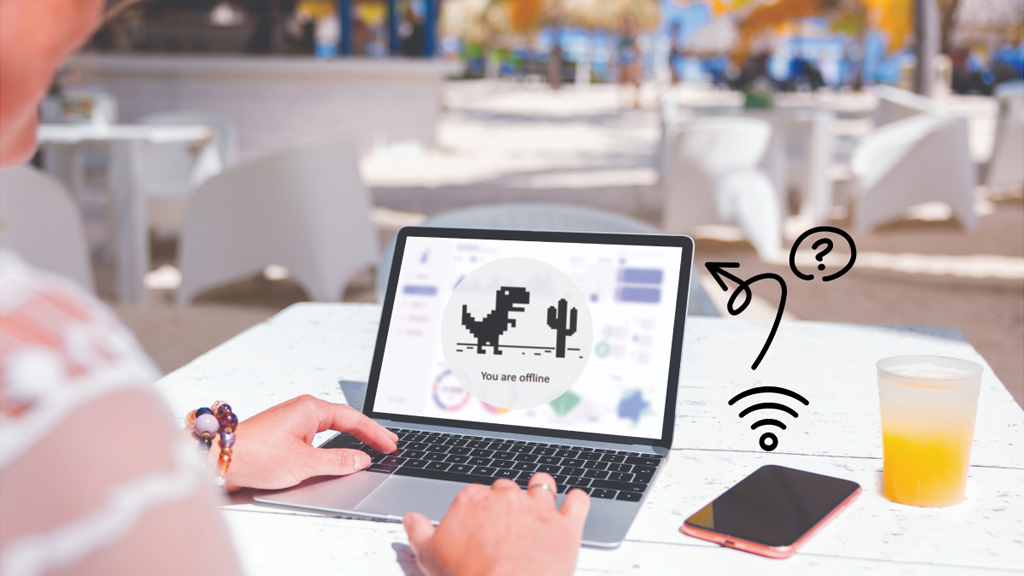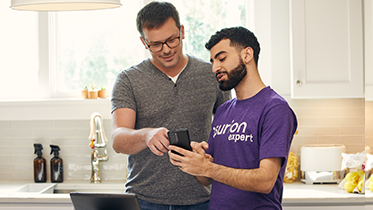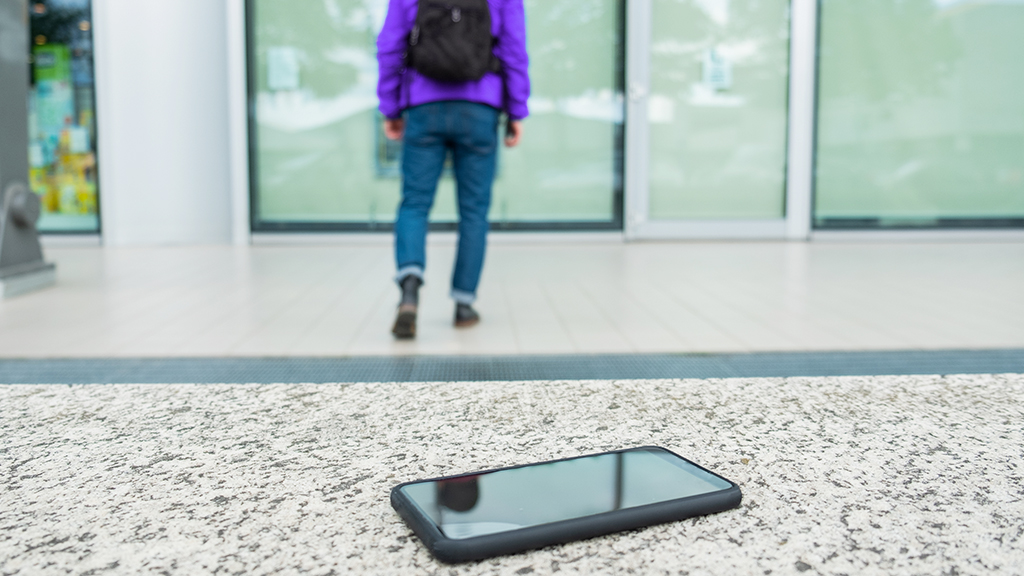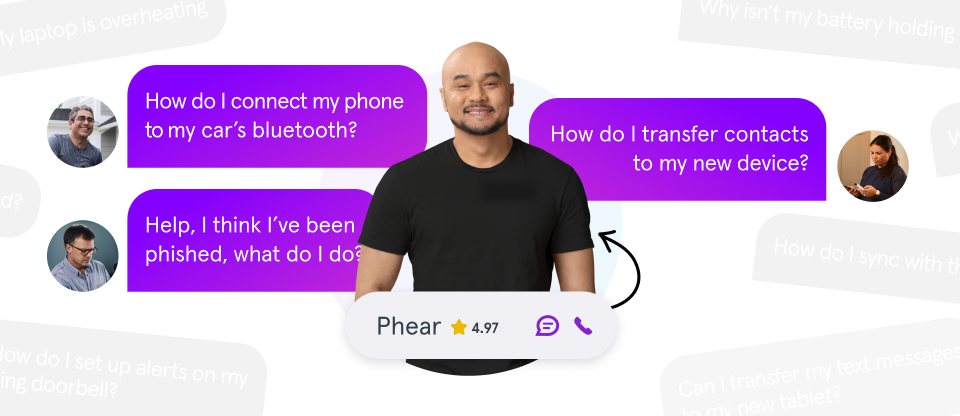When you're traveling or working on the go, it's important to stay connected. But that doesn't mean you have to rely on public Wi-Fi, which may not always be secure. Instead, you can use your phone to share an internet connection with your laptop, tablet, and other devices—unless using your phone as a mobile hotspot isn't working.
Fortunately, Asurion Experts come across issues like this every day, from phones not turning on to those with swollen batteries. When tech breaks, we fix it. If you're having trouble using your phone as your personal hotspot, try not to get heated yourself. Check out our tips for fixing your hotspot so you can keep your devices connected, no matter where you are.
What is a mobile hotspot?
A mobile hotspot lets you share your phone's cellular service with other devices. It's different from both a portable and public hotspot. Here's why:
- A portable hotspot, like a Jetpack® from Verizon® or a Nighthawk® from AT&T®, is a device available through your wireless carrier. It uses mobile networks to connect to the internet, similar to your phone, but has its own Wi-Fi network.
- A public hotspot, or public Wi-Fi, is the free wireless network you might access in coffee shops and airports.
How a mobile hotspot works
Most smartphones, including the Samsung Galaxy® and iPhone®, have built-in features that allow you to use your mobile data and transmit it to other devices. These wireless transmitters act as a mini Wi-Fi network (or hotspot) you can quickly turn on in your Settings or App menu.
Unlike public Wi-Fi hotspots, a mobile hotspot is safer to use (especially when you need a hotspot for a student who’s remote learning). You can put extra security measures in place, such as a unique password, to protect your personal information from potential threats on a public network.
Why is my hotspot not working?
Even though your iPhone or Android mobile hotspot carries less risk than the public one in your hotel lobby, it can still run into a few common issues and stop responding. Here are the reasons Asurion Experts see most:
- Phone carrier – Your wireless carrier may be experiencing technical issues on its end, which could affect your mobile hotspot, or your account may not allow you to use one. Be sure to check your plan to ensure your phone has hotspot capability (it sometimes has to be added before you use it).
- Signal strength and mobile data – No bars? Bad signal strength may be to blame for your personal hotspot not working. Your device also requires mobile data or Wi-Fi, and if it isn't available or you've reached your data limit, you may not get a connection.
- Settings – This may seem simple, but the reason your hotspot is not working could be that you never turned on the feature in settings. You may also have trouble connecting because of an incorrect password or Wi-Fi name or because of a problem with your virtual private network (VPN) settings.
How to fix a hotspot that is not working
Android or iPhone hotspot not working? There are several ways to fix your hotspot issues without going to extremes—like turning to dial-up. Here's what Asurion Experts recommend:
1. Restart and turn off battery saving mode
A simple restart can solve more problems than you think. First, turn your phone off and on again, then turn off Low Power Mode or power saving mode if you have it enabled—this setting can sometimes interfere with your device's hotspot. Here's how to do it:
iPhone: Open Settings > Battery > Low Power Mode. Tap the switch to turn it off.
Android:
- Open Settings > Battery and device care > Battery. If you don't see those options, try Settings > Battery > Battery Saver.
- Tap the Power saving switch, or Use Battery Saver on some phones, to turn it off.
2. Adjust your Wi-Fi or VPN settings
Putting your phone in Airplane mode for a brief time will turn off Wi-Fi and mobile data, which can help reset your network and solve the issue. To turn on Airplane mode, follow these steps:
iPhone X or later:
- Swipe down from the top-right corner of your screen to open the Control Center; for older models, swipe up from the bottom edge of your phone.
- Tap the Airplane icon to turn on Airplane Mode. Wi-Fi and mobile data will turn off.
- After 30 seconds, tap the Airplane icon again and try to connect to the hotspot's Wi-Fi network.
Android:
- Swipe down from the top of the screen to open your quick settings menu.
- Tap the Airplane icon to turn on Airplane mode. Wi-Fi and mobile data will turn off.
- After 30 seconds, tap the Airplane icon again and try to connect to the hotspot's Wi-Fi network.
Using a VPN (Virtual Private Network) on your phone? Shutting them off may improve your hotspot connection. Here's how to turn off your VPN:
iPhone: Open Settings, then tap the VPN button to turn it off.
Android:
- Open Settings > Connections > More connection settings or Settings > Network & internet.
- Tap VPN to turn off your VPN.
If using a Domain Name System (DNS), turning it off may also help. Here’s how to do so in a few steps:
iPhone:
- Open Settings > Wi-Fi.
- Tap the information icon next to the Wi-Fi you're using, then tap Configure DNS.
- If it's not set to Automatic, tap Automatic and try to test your hotspot.
Android:
- Open Settings > Connections > More connection settings or Settings > Network & internet > Private DNS.
- Tap Private DNS to turn off your DNS server.
3. Check for software updates
If you haven't updated your phone in a while, old software may be to blame for your hotspot issues. Check for any available updates in Settings and make sure you've installed the latest version of your operating system (OS). It's simple:
iPhone: Open Settings > General > Software Update. If an update is available, tap Install.
Android:
- Open Settings > Software update. If you don't see these options, you can also open Settings > System > System update.
- If an update is available, an Update button will appear—tap it.
- Depending on the OS version, tap Install Now, Reboot and install, or Install System Software.
4. Lower the frequency band on your phone
Newer phones can transmit data faster over a Wi-Fi network because they use a 5 GHz frequency band. But if the device you're trying to connect with doesn't support this frequency, you may need to switch to a lower one (like 2.4 GHz) for your phone's mobile hotspot to work successfully. Here's how to change the frequency band on your phone:
iPhone 12 and newer models:
- Open Settings > Personal Hotspot.
- Tap Maximize Compatibility. This will force your hotspot to use the 2.4GHz band.
Android:
- Open Settings > Connections > Mobile Hotspot and Tethering. If you don't see these options, open Settings > Network & internet > Hotspot & tethering.
- Tap Mobile Hotspot > Configure > Band or Wi-Fi hotspot.
- If 5 GHz is already chosen, tap 2.4. On some phones, you have to turn on Extend compatibility to enable the 2.4GHz band.
5. Reset your network settings
When your mobile hotspot won't work, resetting your network settings may be your only option. This only clears your Wi-Fi passwords and saved networks—it doesn't delete any other data. After you've tried everything else, do this:
iPhone:
- Open Settings > General > Reset.
- Tap Reset Network Settings. You may have to enter your passcode to confirm the reset.
- Tap Reset Network Settings again.
Android:
- Open Settings > General Management > Reset. If you don't see these options, open Settings > System > Reset options.
- Tap Reset network Settings > Reset settings. For some models, you may need to tap Reset Wi-Fi, mobile & Bluetooth > Reset settings.
Tried these steps and still need help? We got you. Get your tech problem solved when you call or chat with an expert now.





